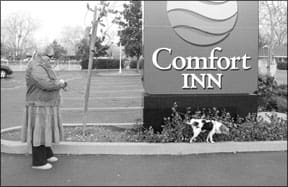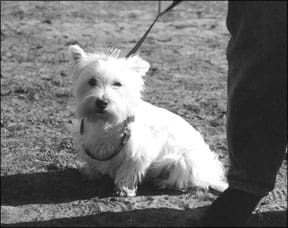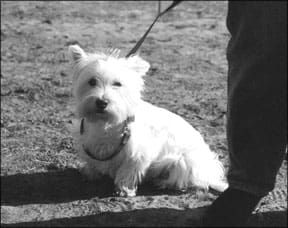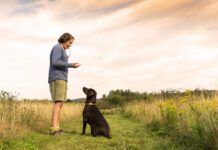[Updated July 6, 2018]
HOUSE TRAINING TIPS: OVERVIEW
1. Implement a consistent and effective housetraining program early in your dog’s life – don’t wait for new carpeting!
2. Teach your dog to eliminate on cue to make potty trips hassle-free and life easier.
3. Training is not always the answer. Consider management solutions if you’re dealing with extra-challenging bathroom behaviors with your dog.
Teaching your dog to eliminate on cue is such a valuable “trick” once your dog knows how, you will wonder how you ever coped without it. No more standing around shivering at night, waiting for “that magic moment.” No more walking around the block endlessly in frustration, when you have to get to work. No more “finding” poop on the bottom of your shoe in a part of the yard where you really didn’t expect to find it! And, we hope, no more “accidents” in the house.
House Training Dogs is Really Easy
Sound too good to be true? As long as you consistently practice with your dog, it’s actually relatively simple to put her elimination on cue, since the behavior of a dog is reasonably easy to predict.
You know your dog is going to pee at certain times of the day, such as when you take her outside first thing in the morning; you just have to be awake enough to remember to give the cue an instant before the stream starts. You’ll also need treats in your pocket, a reward marker at the ready (such as a clicker in your hand, or a readiness to use a verbal marker, such as the word “Yes!”), and your dog on a leash.

At regular intervals throughout the day, take your dog to her potty spot and wait. When you see the unmistakable signs that she’s about to pee, give your potty cue. When she’s done, click! (or use your verbal marker) and give her a treat. Be careful not to use your marker until she’s finished! If you click! in midstream, she may well stop to get the treat, and probably won’t finish, since her bladder no longer feels full. Then you’ll take her back inside with a half-full bladder and she’ll be likely to have an accident prior to her next scheduled potty break. Oops!
After you’ve marked and rewarded her efforts, spend a few minutes playing with her outside. Some dogs learn that outside fun is over as soon as they’re empty, and “hold it” as long as they can to prolong playtime. Potty first, then play, so your dog is willing to eliminate quickly in anticipation of the play reward as well as the treat. If your dog doesn’t produce any results on her bathroom trip, be sure to supervise her closely or even crate her until her next trip outdoors.
Owners often agonize over what word to use as a bathroom cue. It doesn’t matter to the dog what cue you use. As long as you consistently associate the word with the action, she’ll figure it out. Some suggestions include go pee, (this is what I use, both for urination and defecation), go potty, go shi-shi (apparently a Hawaiian and Japanese slang word for urinating), hurry up, or break time.
If you consistently cue your dog to “go” every time you take her out, in time you’ll be able to jump-start her potty performance by giving the cue no matter where you are.
Behavioral Management is the Key to House Training
Whether you’re facing the challenge of housetraining a new puppy or retraining an adult dog with inappropriate bathroom behaviors, the approach is the same: manage the behavior to prevent mistakes from happening while you teach appropriate toilet habits.
The differences are that while a puppy may not yet have the physical ability to control his need to eliminate for long periods, at least he probably hasn’t learned to soil indoors and will have a very strong instinct to keep his den clean. The unfortunate exceptions are puppies raised in very dirty conditions (like many of the puppies raised in puppy mills and sold through pet stores), and those who have been forced to soil their crates repeatedly through improper confinement.
A healthy adult dog is perfectly capable of controlling his elimination urges, so in some cases an adult dog can be housetrained very quickly, especially if she hasn’t spent much time indoors. If, however, she has a longstanding habit of urinating and/or defecating indoors, reliable housetraining can be a frustrating goal to achieve. In these cases we sometimes must settle for managing the dog behavior in order to prevent house soiling.
We use the “umbilical approach” to housetraining puppies and adult dogs. This means the dog is always either in a crate or pen, on a leash attached to you (or restrained nearby), under the direct supervision of an adult or responsible teen, or outdoors. Establish a daytime routine go out with the dog every one to two hours. If you want him to use a particular bathroom area of the yard, always take him on leash to this same spot when you go out with him. Don’t just send him out to “do his business” on his own. You won’t know if he did anything or not, and you won’t be able to reward him for doing the right thing.
Go with him outside. When he urinates or defecates, click! a clicker (or use a verbal marker, such as the word “Yes!”) and feed him a treat. Then play with him for a few minutes before bringing him indoors, as a reward for going. If he doesn’t go, bring him back in, put him in his crate, and try again in a half-hour or so. When you know he’s “empty,” you can give him some relative but still supervised freedom for a half-hour or so.
If he has a mistake indoors, don’t punish him after the fact. It’s your mistake, not his. He won’t even know what he’s being punished for. Quietly clean it up using an enzyme-based cleaner like Nature’s Miracle to be sure you get all the odor, and vow not to give him so much freedom.
If you catch him in the act, calmly interrupt him and take him outside to his bathroom spot. Again, don’t punish him. If you do, you’ll only teach him that it isn’t safe to toilet in front of you, and he’ll learn to run to the back bedroom to do it.
Keep a daily log for one week, writing down when (and what) he goes. Once you have this documentation of his routine, you can start reducing the number of times you take him out, based on his elimination schedule. As he becomes more trustworthy, you can start to give him more freedom. If he backslides it’s your fault, for giving too much freedom too soon. Back up to a more restricted routine, and proceed more slowly.
At night he should be crated, in or near your bedroom. If he wakes up in the middle of the night and cries, he probably has to go out. You must wake up and take him out, click! and reward when he goes, then bring him back and immediately return him to his crate. You don’t want to teach him that crying at night earns a play session!
Dogs do not house soil out of malice or spite; they just don’t think that way. If your dog urinates or defecates every time you leave him alone in the house, chances are it’s related to stress, perhaps separation anxiety, not malice. Punishing him will only make him more stressed, and make the problem worse.
If you’re having serious housetraining problems, you may need the services of a trainer or behavior consultant. Most dogs, thank goodness, want to keep their dens clean and will happily learn to use appropriate bathroom spots if given the chance. It’s just one of the many things we love about them.
The Elimination Zone
It’s very helpful to teach your dog to eliminate whenever and wherever you need him to, especially if you live in a city environment, or in apartment or condominium without a yard. And there are times when you are with your dog when you absolutely do not want him to eliminate, so asking him to empty his bowels and bladder before you get there is a useful exercise.
But even those of us with yards or even vast acreage can benefit from teaching our dogs to eliminate on cue — and to dedicate a certain area in the yard for that task. It’s nice to know, no matter where you walk on your property, you are not likely to step in a dog-doo landmine when you aren’t expecting it! People with extensive landscaping or perfect lawns will also appreciate the benefits, such as the lack of unsightly brown spots in the green grass! Dedicating one part of your yard for your dog’s elimination also makes it a breeze to clean.
It’s a good idea to regularly practice both tasks: asking your dog to eliminate in a new location, and having him use a dedicated potty area at home. Take him straight to the desired spot at times when you know he has to go, use your cue, and reward/reinforce the behavior with treats or a few minutes of playing with his favorite toy.
An Example of Adult-Dog House Training
Heather is a 12-year-old West Highland White Terrier who came to see me last week because, according to her owners, she had recently started urinating indoors. The Hadleys had just moved to a brand-new house with wall-to-wall carpeting, and Heather was destroying the rugs.
I was concerned. While the break in Heather’s housetraining could certainly be due to the stress of the move and any change in routine that might have occurred along with it, whenever there’s a behavior change in an a mature adult dog, especially a senior canine, there’s always a strong possibility that it could be a medical problem, perhaps a serious one.
It turned out my fears for Heather’s health were groundless. As I explored the Westie’s history with her two devoted humans, we came to the conclusion that the little dog had never been fully housetrained. Their previous home had hardwood floors and throw rugs that were easily tossed into the washing machine whenever Heather had an occasional accident, so the lapses in training were never of huge concern to the Hadleys.

Looking back even further, it turned out that Heather had come from a puppy mill environment, forced to live in her own urine and feces, and even as a pup was willing to soil her crate and lie in it. And while Tim insisted that Heather could “hold it” for several hours when shut in the bathroom when they left her alone, Sue confessed to having cleaned up puddles without telling Tim from time to time over the years.
The good news was that Heather was healthy. The bad news was this was not a new behavior we were dealing with – it was a well-established, 12-year-old behavior. New behaviors are almost universally easier to fix than ones the dog has practiced for a long time.
While the prognosis for completely modifying a behavior that was more than a decade old wasn’t bright, there were a number of things I could offer the Hadleys that would help preserve their new carpeting. My suggestions included:
– Putting Heather’s urination behavior on cue.
– Starting over with their Westie as if they were housetraining a brand-new puppy: total supervision, with gradually increasing periods of house freedom as Heather came to understand that peeing indoors was no longer acceptable behavior.
– Teaching Heather to give them a signal when she had to go out.
– Training her to use an indoor litter-box.
– Using doggie diapers.
Heather’s owners wanted to teach her to bark to let them know she had to go out. On rare occasion, they said, she would bark when she had to defecate and she never defecated in the house. But other than that, she never barked, even when they tried to elicit barking behavior. I suggested that it would be easier to teach her a different signal ringing a portable electronic doorbell button that they could also take with them when they traveled.
Heather hadn’t received any formal training, and didn’t know how to target, so we started teaching her. Since Heather also wasn’t inclined to paw at things, we elected to use nose targeting instead of foot targeting (see “Utilize Target Training for Better Leash Walking“). In less than 10 minutes she was touching her nose to the doorbell button in order to get a click! and treat. She wasn’t ringing it yet that would be one of Tim and Sue’s homework assignments. The ease with which she caught on to the concept of “touch” bodes well for success with her doorbell-ringing task.
When Heather can ring the doorbell easily, the Hadleys will ask her to ring it every time they’re ready to take her out to potty. In time, she should start offering to ring it without being asked, to tell them she needs to go out.
The Hadleys also liked the idea of providing an indoor litter box for Heather (see “Indoor and Patio Litterboxes for Home-Alone Dogs“). We agreed that Heather would probably never be a super hold-it dog – a realistic goal might be three to four hours maximum, not the 8 to 10 hours that some dogs are capable of when necessary. A litter box would give her a “legal” place to go indoors when she had to be left alone for longer than she could hold it.
Sue had tried a litter box once but Heather ate the litter pellets, so she gave up. I suggested some artificial turf as a less palatable alternative, and explained they could train their dog to use it the same way they taught her to use a potty spot outdoors. They could start with the plastic box, lined with the artificial grass and positioned in Heather’s outdoor bathroom spot, and coax her to jump in it to eliminate. When she would use it outdoors, they could move it indoors. When the box got soiled, the turf and plastic container would be easy to clean.
Finally, we discussed the possibility of doggie diapers as a last resort to save the new carpeting. Available from most pet supply catalogs and websites, these slip over a female dog’s hindquarters, or a belly band wraps around a male dog’s abdomen. Diapers are a management measure, although because many dogs don’t want to soil themselves, they can also help with training.
My husband and I have used a diaper on our Scottie, who started urine-marking indoors when we moved to a house that, previously, had been occupied by a dog who wasn’t well housetrained. After more than a year of scrupulous management, we are now giving Dubhy supervised freedom without the band, and he’s doing well.
The Hadleys were pretty sure that Heather would chew off the diapers, but agreed to give them a try if the other measures weren’t sufficient to prevent indoor accidents.
I asked my clients to report back to me two weeks after their first session, to see how the program is working. I haven’t received Heather’s first progress report yet, and I’m eager to hear of the Hadley’s success. Both Tim and Sue appeared committed to all aspects of the program and capable of carrying them out. Looking into my crystal ball, I predict a bright, stain-free future for Heather and the Hadley’s new carpeting.







Your tips on how to make a dog focus on a certain area when doing toilet business were definitely the most helpful from your article. Cleanliness and hygiene are the things I want to focus on the most when I become a dog owner, as my wife has always been wary of the mess pets can make. I’ll keep these tips in mind so I can prioritize them when I attend online dog training sessions.